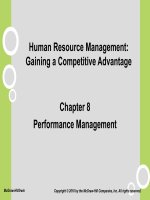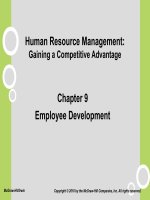HRM gaining a competitive advantage noe ch012
Bạn đang xem bản rút gọn của tài liệu. Xem và tải ngay bản đầy đủ của tài liệu tại đây (117.36 KB, 21 trang )
Human Resource Management:
Gaining a Competitive Advantage
Chapter 12
Recognizing Employee Contributions
with Pay
McGraw-Hill/Irwin
Copyright © 2010 by the McGraw-Hill Companies, Inc. All rights reserved.
Learning Objectives
Discuss how pay influences individual employees.
Describe three theories that explain
compensation’s effect on individuals.
Describe pay programs for recognizing employees’
contributions to the organization’s success.
List pay programs’ advantages and disadvantages.
12-2
Learning Objectives
Describe how organizations combine incentive
plans in a balanced scorecard.
Discuss issues related to executives’
performance-based pay.
Explain the importance of process issues such as
communication in compensation management.
List major factors in matching pay strategy to the
organization’s strategy.
12-3
Introduction
Organizations have discretion in deciding how to
pay.
Each employee’s pay is based upon individual
performance, profits, seniority, or other factors.
Regardless of cost differences, different pay
programs can have different consequences for
productivity and return on investment.
12-4
Pay Influences Individual Employees
3 Theories Explain Compensation’s Effects:
Reinforcement
Theory
Expectancy
Theory
Agency
Theory
12-5
How Pay Influences Individual Employees
Reinforcement Theory - A response followed
by a reward is more likely to recur in the future.
Expectancy Theory - Motivation is a function of
valence, instrumentality, and expectancy.
Agency Theory- interests of the principals
(owners) and their agents (managers) may
nolonger converge.
12-6
Agency Costs
Agency costs may be minimized by the principal
choosing a contracting scheme that alignsagent’s
interests with principal's interests.
6 Factors that Influence Type ofContract:
1. risk aversion
2. outcome uncertainty
3. job programmability
4. measurable job outcomes
5. ability to pay
6. tradition
12-7
Programs Recognizing Contributions
Programs differ by payment method,payout frequencyand ways
of measuring performance.
Potential consequences include employees’ performance
motivation and attraction, culture and costs.
Management style and type of work influence whether a pay
program fits the situation.
Merit Pay
Incentive Pay
Profit
Sharing
Skill-based
Gain
Sharing
Ownership
12-8
Merit Pay
Merit pay programs link performance-appraisal
ratings to annual pay increases.
A merit increase grid combines an employee’s
performance rating with the employee’s position
in a pay range to determine the size and
frequency of his or her pay increases.
Some organizations provide guidelines
regarding percentage of employees who should
fall into each performance category.
12-9
Merit Pay
Edward W. Deming, a critic of merit pay,
arguedthat it is unfair to rate individual
performance because "apparent
differencesbetween people arise almost entirely
from the system that they work in, not the people
themselves.”
Criticisms of merit pay include:
Focus on merit pay discourages teamwork.
Measurement of performance is done unfairly and
inaccurately.
Merit pay may not really exist.
12-10
Individual Incentives
Individual incentives reward individual performance
but payments are not rolled into base pay and
performance is usually measured as physical output
rather than by subjective ratings.
Individual incentives are rare because:
Most jobs have no physical output measure.
Many potential administrative problems.
Employees may do what they get paid for and nothing
else.
Typically do not fit in with team approach.
May be inconsistent with organizational goals.
Some incentive plans reward output at the expense of
quality or customer service.
12-11
Profit Sharing
Under profit sharing, payments are based on a
measure of organization performance (profits), and
payments do not become a part of base pay.
Advantage- profit sharing may encourage employees to
think more like owners.
Disadvantage-workers may perceive their performance
haslessto do with profitthan top management decisions
over which they have little control.
12-12
Ownership
Ownership encourages employees to focus
onorganization’s success, butmay be less motivational the
larger the organization.
One method to achieve employee ownership is through
stock options, which give employees the opportunity to
buy company stock at a previously fixed price.
Employee stock ownership plans (ESOPs) give
employers certain tax and financial advantages when stock
is granted to employees.
– ESOPs can carry significant risk for employees.
12-13
Gainsharing
Gainsharing programs offer a means of
sharing productivity gains with employees and
are based on group or plant performance that
does not becomepart of the employee’s base
salary.
12-14
Gainsharing
8 Conditions for Gainsharing to be Effective:
1. management commitment
2. need and commitment to change and continuous
improvement
3. management's acceptance and encouragement of
employee input
4. high cooperation and interaction
5. employment security
6. information sharing on productivity and costs
7. goal setting
8. agreement on a performance standard and calculation
that is undesirable, seen as fair and closely related to
managerial objectives
12-15
Group Incentives and Team Awards
Group incentivesmeasure performace in terms of
physical output.
Team award plans may use a broader range of
performance measures.
Individual competition may be replaced by
competition between groups or teams.
12-16
Balanced Scorecard
Some companiesdesign a mix of pay programs.
4 Categories of aBalanced Scorecard:
1. financial
2. customer
3. internal
4. learning and growth
12-17
Managerial and Executive Pay
Top managers and executives are a strategically
important group whose compensation warrants
special attention.
In some companies rewards for executives are high
regardless of profitability or stock market performance.
Executive pay can be linked to organizational
performance (from agency theory).
Increased pressure from regulators and shareholders
to better link pay and performance
– Securities and Exchange Commission (SEC)
12-18
Process and Context Issues
3 issues represent areas of significant company discretion
and pose opportunities to compete effectively:
Employee Participation
in Decision Making
Pay&Process:
Intertwined Effects
Communication
12-19
Matching Pay& Organization Strategy
Organization Strategy
Pay Strategy Dimensions
Risk sharing (variable pay)
Time orientation
Pay level (short-run)
Pay level (long-run potential)
Benefits level
Centralization of pay decisions
Pay unit of analysis
Concentration
Low
Short-term
Above market
Below market
Above market
Centralized
Job
Growth
High
Long-term
Below market
Above market
Below market
Decentralized
Skills
12-20
Summary
There are potential advantages and disadvantages of different
types of incentive or pay for performance plans.
Pay plans can have both intended and unintended
consequences.
Designing a pay for performance strategy typically seeks to
balance the pros and cons of different plans and reduce the
chance of unintended consequences.
Pay strategy will depend on the particular goals and strategy of
the organization and its units.
• Many organizations are working to link pay to performance and
reduce fixed labor costs, although sometimes executives
appear slow to reduce what are supposed to be performancebased bonuses when firm performance declines.
12-21









